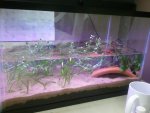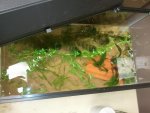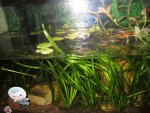Lamb
New member
- Joined
- Feb 28, 2009
- Messages
- 222
- Reaction score
- 12
- Points
- 0
- Age
- 35
- Location
- USA
- Country
- United States
After creating a vivarium for my A. opacum using native ferns, mosses, and a local ginger, I really wanted to try my hand at a completely natural, aquatic set up. So I went for it and have put together my first Walstad/Natural style freshwater aquarium in a 10 gallon. The set up is described below, and I'll post pictures tomorrow. Once the plants are settled and the tank's numbers have been established for a while, I'll use it for a (possibly two) juvenile Gulf Coast waterdogs (Necturus beyeri).
Substrate (from bottom, up):
1 in potting-soil (no chemical additives)
Light layer of larger gravel (as in only 1 piece thick)
3/4 in layer of sand
Plants:
Moneywort, Camboba, corkscrew Vallisneria, java fern. The latter is tied to a piece of terracotta, which I'm hoping it will attach itself to. I considered ordering plants from reputable growers online, but decided to restrict myself to the plants that were available at PetSmart before I tried that. The java fern aren't in good shape, and the Camboba look like they have been abused a little. I'm hoping they will all pull through. PetSmart is notorious for having snails, so I let the plants sit in cold water (10-13 deg. C) for 30 min.
Water:
Aged tap water, and probably rain water when I can get it. Right now, the tank is about 1/2 full. I thought I'd try Molch's method of letting the plants access CO2 at the surface so that they can enjoy a growth spurt.
Lighting:
I have a hood with an 18" fluorescent, 15 watt, full spectrum lamp. This gives the tank between 1-2 watts per gallon when full. We'll see if that's sufficient for the plants. It's on a timer with 11 hours of daylight, with a "siesta" for 1.5 hrs from noon to 1:30 PM. The "siesta" was someone's suggestion to help reduce/control the growth of algae.
Any suggestions? Thoughts? I'm keeping my fingers crossed!
Substrate (from bottom, up):
1 in potting-soil (no chemical additives)
Light layer of larger gravel (as in only 1 piece thick)
3/4 in layer of sand
Plants:
Moneywort, Camboba, corkscrew Vallisneria, java fern. The latter is tied to a piece of terracotta, which I'm hoping it will attach itself to. I considered ordering plants from reputable growers online, but decided to restrict myself to the plants that were available at PetSmart before I tried that. The java fern aren't in good shape, and the Camboba look like they have been abused a little. I'm hoping they will all pull through. PetSmart is notorious for having snails, so I let the plants sit in cold water (10-13 deg. C) for 30 min.
Water:
Aged tap water, and probably rain water when I can get it. Right now, the tank is about 1/2 full. I thought I'd try Molch's method of letting the plants access CO2 at the surface so that they can enjoy a growth spurt.
Lighting:
I have a hood with an 18" fluorescent, 15 watt, full spectrum lamp. This gives the tank between 1-2 watts per gallon when full. We'll see if that's sufficient for the plants. It's on a timer with 11 hours of daylight, with a "siesta" for 1.5 hrs from noon to 1:30 PM. The "siesta" was someone's suggestion to help reduce/control the growth of algae.
Any suggestions? Thoughts? I'm keeping my fingers crossed!



